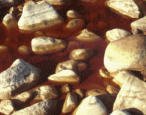Eukaryotes at pH Extremes
When: August 25, 2003 12AM PDT

One of the goals of the Astrobiology Roadmap is to explore the limits of
life on Earth as analogs for environments on Mars, Europa and other planets
that might support life. Earth harbors many extreme environments. Our
preconceived notions concerning the range of habitability for life have
biased many investigations of microbial diversity in these environments. We
have been exploring the genetic and physiological diversity of organisms
living at both acidic (pH < 3) and alkaline (pH >10) pH extremes. I will
present an overview of some of these environments that range from the warm
(45°C), acidic (pH 2.7) Nymph Creek in Yellowstone National Park to
temperate alkaline lakes in the Sandhills region of western Nebraska. The
focus of my presentation, however, will be the acidic, heavy metal rich Rio
Tinto in Southwestern Spain.
Spains Rio Tinto, or Red River, is an example of an extremely acidic (pH
1.7-2.5), high metal environment teeming with prokaryotic and eukaryotic
microbial life. Our recent small-subunit rRNA gene-based studies reveal an
unexpectedly high eukaryotic phylogenetic diversity in the river compared to
the relatively low prokaryotic diversity. We have found that protists in
the river can thrive in and often dominate this environment. I will review
our progress to date on these studies and also provide a glimpse of future
work planned.
Since we have discovered protistan acidophiles closely related to
neutrophiles, we hypothesize that the transition from neutral to acidic
environments occurs rapidly over geological time scales. These studies
identify organisms that live under acid/high metal extremes but tell us
little about how these organisms have adapted to such environments. We are
currently trying to understand how these organisms have adapted to such
environments by exploring the alterations in physiological mechanisms that
might allow for growth of eukaryotic microbes at acid extremes. To this end,
we are isolating phylogenetically diverse protists in order to characterize
and compare ion-transporting ATPases from cultured acidophiles with those
from neutrophilic counterparts. We predict that special properties of these
ion transporters allow protists to survive in the Rio Tinto and other
extreme environments.
To join using a videoconferencing system:
Please RSVP to Mike Toillion (mike.toillion@nasa.gov) if you will be joining by Polycom.
To view the slides, connect to http://connect.arc.nasa.gov/nai_directors_seminar/
To join using a web browser:
The slides and audio/video for this meeting will be presented using Adobe Connect. To join the meeting, connect to:
http://connect.arc.nasa.gov/nai_directors_seminar/
If you are having problems connecting, you can try joining http://connect.arc.nasa.gov/nai_directors_seminar/?launcher=false, or rebooting your computer, or try joining from another network.
 A Talk With Jim Green
A Talk With Jim Green What Can Extant Genomes Reveal About Early DNA Metabolism?
What Can Extant Genomes Reveal About Early DNA Metabolism? What We Talk About When We Talk About Earth's Oxygenation
What We Talk About When We Talk About Earth's Oxygenation Bowling With Astrobiologists: A Twisted Path Toward the Origin of DNA
Bowling With Astrobiologists: A Twisted Path Toward the Origin of DNA